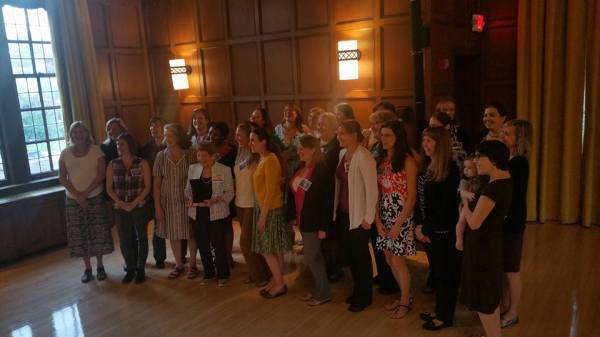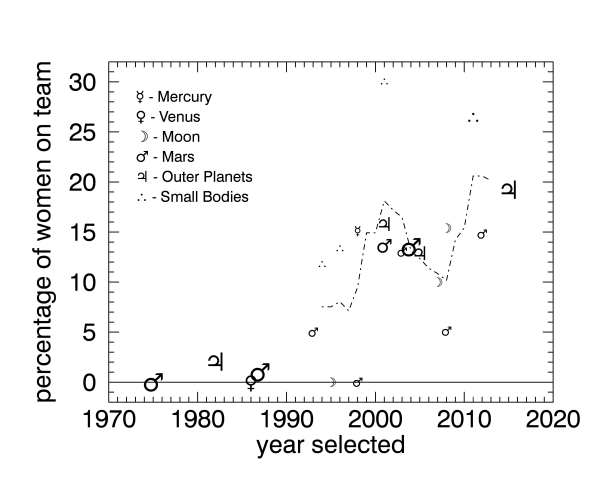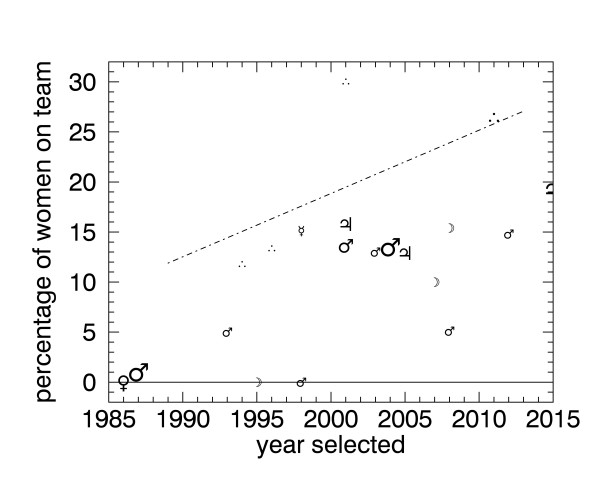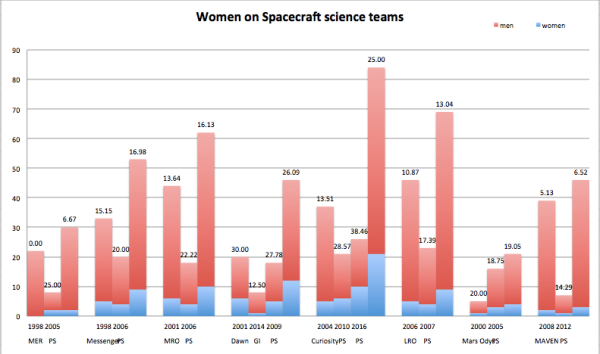The following blog post was written by Dr. Julie Rathbun, Senior Scientist at the Planetary Science Institute and Professor of Physics at the University of Redlands. The post was originally posted at the Women in Planetary Science blog, and is cross-posted here.

The photo above was taken during the July 2016 meeting of the Science Team for the Europa Multiple Flyby mission. All of the women at the meeting (most of whom are members of the science team) wanted to celebrate the accomplishments of women scientists by taking this photo. It was shot after Dr. Margaret Kivelson was honored by the Project with the Monolith award. During her speech, Margie discussed the challenges she’d faced over her more than 50 years as a scientist, many of those due to being one of a very small number of women scientists. For more about her talk, see https://storify.com/LokiVolcano/margaret-kivelson-at-europa-psg.
How far have we come and how far do we still need to go to welcome women into planetary science, and, particularly, spacecraft missions? For the 2015 DPS meeting, together with a great group of volunteers, I found lists of names of the team members for 22 NASA planetary science missions over a period of 41 years. We considered only original team scientists (not engineers, members of project management, nor students or postdocs) from US institutions (since investigators from foreign institutions are generally not funded by NASA). We determined the year each team was selected and the gender presentation of each team member. For more recent missions, generally someone on our team knew the investigator personally, so it was straightforward to determine gender. In other cases, we relied on images of the scientist from web searches and, in a few cases, just the name of the scientist. The most difficult part of the process was often determining the original team membership, without including postdocs, participating scientists, and other additional scientists.
How far have we come and how far do we still need to go to welcome women into planetary science, and, particularly, spacecraft missions? For the 2015 DPS meeting, together with a great group of volunteers, I found lists of names of the team members for 22 NASA planetary science missions over a period of 41 years. We considered only original team scientists (not engineers, members of project management, nor students or postdocs) from US institutions (since investigators from foreign institutions are generally not funded by NASA). We determined the year each team was selected and the gender presentation of each team member. For more recent missions, generally someone on our team knew the investigator personally, so it was straightforward to determine gender. In other cases, we relied on images of the scientist from web searches and, in a few cases, just the name of the scientist. The most difficult part of the process was often determining the original team membership, without including postdocs, participating scientists, and other additional scientists.

The above plot shows our results. The x-axis indicates the year the science team was selected, which the y-axis shows the percentage of women selected. The symbol type shows the destination of the mission while the symbol size indicates the size of the mission (flagship, NF, or Discovery-class). The dotted line shows a running average over a six year window. In the mid-late 1990s, participation by women grew dramatically, from less than 5% to more than 10%. However, the average has remained remarkably consistent since the early 2000s, hovering near 14%. Missions that study small bodies have had the greatest participation of women on their science teams.

The above plot shows the number of women scientists in related fields as a function of time. The only measurement we were able to find specifically for planetary scientists was from the 2011 planetary workforce survey (red triangle). The blue squares show results from DPS surveys (1, 2; although not all planetary scientists are member of DPS). The most detailed survey of women in astronomywas completed by the Committee on the Status of Women in Astronomy (CSWA). The green triangles show the percentage of women non-students. The line shows a linear fit to all the data and predict that the field will reach parity in 2049.

The above plot combines the data from the previous two. The same mission data is shown, as well as the line indicating the percentage of women in the field. Note that only 2 missions have had more women than the average in the field, 20 of them have had fewer women on their teams, most have had substantially fewer. And, although the percentage of women in the field continues to rise, the percentage involved in spacecraft science teams has remained stagnant, at near 15%.

While our earlier analysis concentrated on the originally selected teams, we have recently examined Participating Scientist and Guest Investigator programs. These programs are run through NASA ROSES calls much like R&A grants and all selections are available on nspires. We examined the names of the selected scientists and determined their gender in the same way as for the original teams. The above bar graph shows results for several missions. The blue bar indicated the number of women in the selection which the red bar the number of men. The number at the top of each bar indicates the percentage of women selected. The leftmost bar for each mission indicated the originally selected team while the rightmost bar indicates the total team that resulted from the original selection plus the additional members. We will be presenting these new results at the 2016 DPS meeting.
In general, Participating Scientist programs selected a higher percentage of women than the initial mission (20% versus 14%). Only two missions selected a higher percentage of women in the initial mission, Dawn, which, at 30%, had the largest percentage of women on any initial science team, more than twice the average of most missions, and Mars Odyssey, which had a similar percentage of women initially and in the Participating Scientist Program (20% and 18%). However, since the number of scientists selected as Participating Scientists is substantially less than the number selected in the original team, the final percentage of woman on any team remained lower than the percentage in the field (16% on average). Only Curiosity, which has had two rounds of PS selections, improved the percentage of women substantially (13.5% to 25%).

While our earlier analysis concentrated on the originally selected teams, we have recently examined Participating Scientist and Guest Investigator programs. These programs are run through NASA ROSES calls much like R&A grants and all selections are available on nspires. We examined the names of the selected scientists and determined their gender in the same way as for the original teams. The above bar graph shows results for several missions. The blue bar indicated the number of women in the selection which the red bar the number of men. The number at the top of each bar indicates the percentage of women selected. The leftmost bar for each mission indicated the originally selected team while the rightmost bar indicates the total team that resulted from the original selection plus the additional members. We will be presenting these new results at the 2016 DPS meeting.
In general, Participating Scientist programs selected a higher percentage of women than the initial mission (20% versus 14%). Only two missions selected a higher percentage of women in the initial mission, Dawn, which, at 30%, had the largest percentage of women on any initial science team, more than twice the average of most missions, and Mars Odyssey, which had a similar percentage of women initially and in the Participating Scientist Program (20% and 18%). However, since the number of scientists selected as Participating Scientists is substantially less than the number selected in the original team, the final percentage of woman on any team remained lower than the percentage in the field (16% on average). Only Curiosity, which has had two rounds of PS selections, improved the percentage of women substantially (13.5% to 25%).
No comments:
Post a Comment